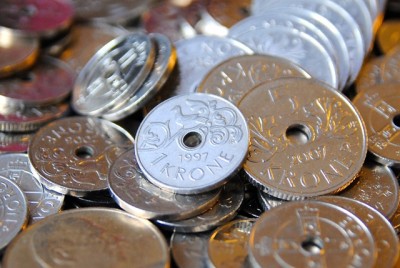The cost of one US dollar fell under 10 Norwegian kroner for the first time since last winter on Thursday. It didn’t last long, but Norway’s embattled currency has been steadily gaining strength for the past week, possibly because of less uncertainty around inflation and interest rates.

“Inflation was surprisingly high, both for the market and for Norges Bank,” Nils Kristian Knudsen, currency strategist for Handelsbanken, told newspaper Dagens Næringsliv (DN) when a dollar “only” cost NOK 10.20 last week. On Thursday morning, it cost NOK 9.92. One euro, meanwhile, cost NOK 11.14 (down from 11.72 earlier this month) on Thursday and a British pound cost NOK 12.82, compared to more than NOK 13 in recent weeks.
Knudsen and others believe the high inflation rate led to a “repricing” and reevaluation of how Norwegian interest rates will develop. They’re likely to keep rising and the krone will be better able to tackle uncertainty in the market. The US inflation rate, meanwhile, has fallen, meaning that US interest rates may ease and the dollar won’t be as expensive as it has been.
The price of a barrel of Norway’s North Sea crude oil has also risen, to nearly USD 80 a barrel, and that almost always boosts the value of the country’s currency. Russian oil production is also expected to decline, so that can keep pushing North Sea crude oil prices up.
It’s “probably a combination” of all this that’s boosted the krone, after a period of record weakness against the dollar, the euro, the British pound and the Swedish- and Danish krone. Now 100 Swedish kroner cost less than NOK 100 instead of more: steady at NOK 97 on Thursday morning.
While it’s been relatively expensive for Norwegians to travel abroad, because of their weak currency, Norway’s own travel and tourism industry has been enjoying a record strong summer. Norway’s notoriously high prices have become less onerous for Americans, Europeans and Asians who’ve been flocking to Norway in droves all year. Myriad media reports have noted how tourists in Norway feel like they’re at least getting a “krone rebate” this year, taking some of the sting out of hotel and restaurant bills.
“I’d say it’s ‘less expensive’ than it could have been,” one father of five from Pennsylvania told DN after riding a gondola in Romsdal, “but it’s still expensive.”
Other major Norwegian industries, in addition to oil and gas, have also been benefiting from the weak krone when their goods are sold in dollars and euros. Seafood exports hit another new record this month, reporting sales equivalent to NOK 82 billion in the first half of this year, thanks to high prices and a currency effect valued at NOK 8 billion.
Norwegian banks, meanwhile, have also been raking in even more profits than before on all the recent increases in interest rates that already have taken place. Many feel the central bank still needs to raise rates, perhaps beyond the 4.25 signaled for August, to curb Norway’s highest inflation rate in years (6.4 percent in June).
Economists and analysts continue to argue over why Norway’s currency has been so weak, given how the economy has remained surprisingly strong as have the prices for oil and gas. Some investors have blamed the Labour-Center government, which has raised taxes and political risk.
Øystein Dørum, chief economist for the national employers’ organization NHO, claims the weak krone isn’t only the government’s fault. He notes that Norway isn’t as “different” from other countries than it used to be, because of lower oil prices than a decade ago and efforts to move away from oil for climate reasons. Dørum also notes that Norway has gone from having higher interest rates than its trading partners (especially the US and the EU) to having lower interest rates. That’s made krone investments less attractive. The krone also remains “a small, illiquid” currency, less in demand in insecure times, Dørum wrote in a recent commentary.
Others including Dane Cekov, a currency strategist at Nordea, argue that the krone was artificially strong for many years. Now the globalization trend is reversing, oil prices may remain relatively low, and industry wasn’t as competitive with a strong krone.
Few think, though, that Norway’s krone will return to levels of NOK 7-8 to the US dollar, which was standard for many years. Cekov and Kari Due-Andresen, chief economist at Akershus Eiendom think it may return to NOK 9, but not much below that.
“The krone will probably be weaker than it was compared with what was perhaps the golden age of the Norwegian petroleum sector,” Due-Andresen told newspaper Aftenposten. Despite political attempts to keep that sector strong, it’s bound to weaken itself, sooner or later, with no serious “new oil” sectors in sight.
NewsinEnglish.no/Nina Berglund

